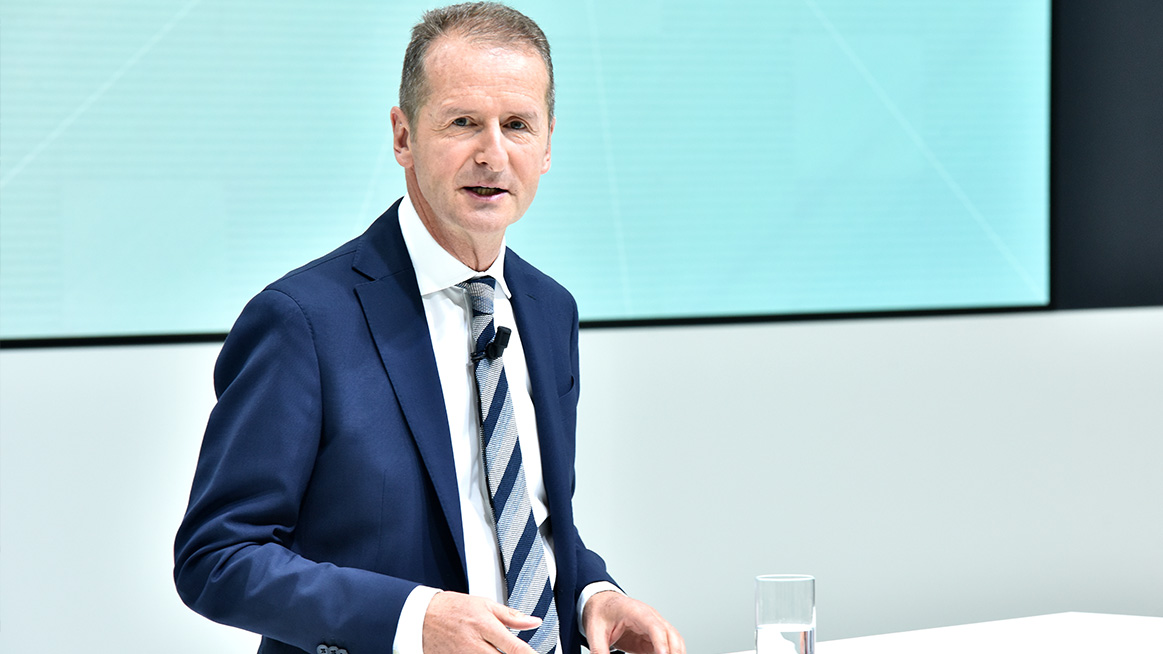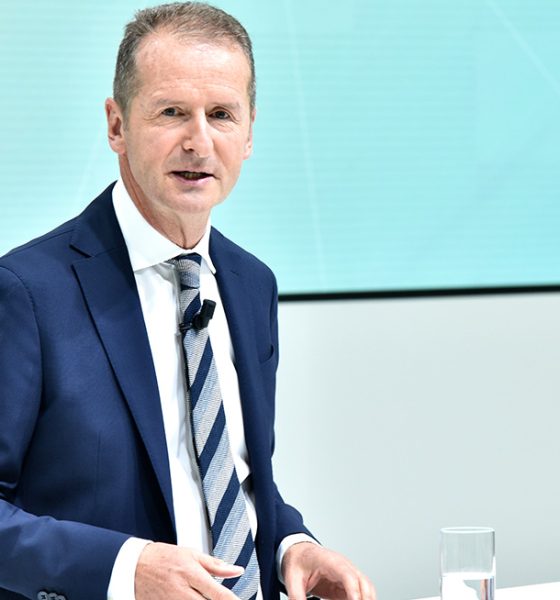

News
VW CEO Diess criticizes hydrogen cars for the climate: ‘Please listen to the science!’
Volkswagen Auto Group CEO Herbert Diess is voicing his distaste for using hydrogen to solve global climate issues. “Please listen to the science,” Diess said in a Tweet.
Citing a report from German media outlet Handelsblatt, Diess said that hydrogen-powered vehicles have been proven not to be as environmentally conscious as they once were thought to be. Instead, Diess suggests that companies should focus on electrification, a narrative that many companies under the Volkswagen AG umbrella have announced they are joining. The most recent being Italian carmaker Lamborghini, which Volkswagen AG owns.
Das Wasserstoff-Auto ist nachgewiesen NICHT die Klimalösung. Im Verkehr hat sich die Elektrifizierung durchgesetzt. Scheindebatten sind reine Zeitverschwendung. Bitte auf die Wissenschaft hören! @ArminLaschet @OlafScholz @andreasscheuer @ABaerbock https://t.co/LfErDmBs5R
— Herbert Diess (@Herbert_Diess) May 18, 2021
Diess said (via Google Translate):
“The hydrogen car is proven NOT to be the solution. Electrification has established itself in traffic. Sham debates are a waste of time. Please listen to the science!”
The Handelsblatt report that Diess cited shows that a new study from the Potsdam Institute for Climate Impact Research (PIK) has concluded that hydrogen cars are not the way to achieve climate neutrality. Instead, scientists who performed the study indicate that battery electric cars (BEVs) are more sustainable and can be a more environmentally-conscious option for those who are concerned about their car’s emissions.
The Handelsblatt report states:
“Rather, direct use of electricity would make more economic and ecological sense in the coming years, especially in the passenger car sector. It is also criticized that new hydrogen-based fuels could keep combustion technology alive longer, which in turn would ensure continued dependence on fossil fuels and thus further greenhouse gas emissions and endanger the climate targets.”
Additionally, Falko Ueckerdt, the lead author of the study and a PIK scientist, said:
“Such fuels as a universal climate solution are a bit of a false promise. While they are wonderfully versatile, they cannot be expected to replace fossil fuels on a large scale. This can only be achieved with direct electrification.”
The study highlights the high-energy requirements of hydrogen vehicles, which use substantially more electricity to produce an EV. The study states that the production uses between two to fourteen times the amount of electricity is needed for combustion engine cars in manufacturing. Hydrogen-powered cars utilize around five times as much energy as BEVs.
Diess, who has become one of the most vocal automotive frontmen in the industry in support of electrification, has led Volkswagen to become one of the major OEMs in the transition to EVs. Over the past two years, Diess has taken Volkswagen from the depths of the Dieselgate controversy to the heights of the EV sector, with its ID.4 winning 2021’s “World Car of the Year” Award for 2021.
What do you think? Let us know in the comments below, or be sure to email me at joey@teslarati.com or on Twitter @KlenderJoey.

News
Tesla FSD fleet is nearing 7 billion total miles, including 2.5 billion city miles
As can be seen on Tesla’s official FSD webpage, vehicles equipped with the system have now navigated over 6.99 billion miles.

Tesla’s Full Self-Driving (Supervised) fleet is closing in on almost 7 billion total miles driven, as per data posted by the company on its official FSD webpage.
These figures hint at the massive scale of data fueling Tesla’s rapid FSD improvements, which have been quite notable as of late.
FSD mileage milestones
As can be seen on Tesla’s official FSD webpage, vehicles equipped with the system have now navigated over 6.99 billion miles. Tesla owner and avid FSD tester Whole Mars Catalog also shared a screenshot indicating that from the nearly 7 billion miles traveled by the FSD fleet, more than 2.5 billion miles were driven inside cities.
City miles are particularly valuable for complex urban scenarios like unprotected turns, pedestrian interactions, and traffic lights. This is also the difference-maker for FSD, as only complex solutions, such as Waymo’s self-driving taxis, operate similarly on inner-city streets. And even then, incidents such as the San Francisco blackouts have proven challenging for sensor-rich vehicles like Waymos.
Tesla’s data edge
Tesla has a number of advantages in the autonomous vehicle sector, one of which is the size of its fleet and the number of vehicles training FSD on real-world roads. Tesla’s nearly 7 billion FSD miles then allow the company to roll out updates that make its vehicles behave like they are being driven by experienced drivers, even if they are operating on their own.
So notable are Tesla’s improvements to FSD that NVIDIA Director of Robotics Jim Fan, after experiencing FSD v14, noted that the system is the first AI that passes what he described as a “Physical Turing Test.”
“Despite knowing exactly how robot learning works, I still find it magical watching the steering wheel turn by itself. First it feels surreal, next it becomes routine. Then, like the smartphone, taking it away actively hurts. This is how humanity gets rewired and glued to god-like technologies,” Fan wrote in a post on X.
News
Tesla starts showing how FSD will change lives in Europe
Local officials tested the system on narrow country roads and were impressed by FSD’s smooth, human-like driving, with some calling the service a game-changer for everyday life in areas that are far from urban centers.

Tesla has launched Europe’s first public shuttle service using Full Self-Driving (Supervised) in the rural Eifelkreis Bitburg-Prüm region of Germany, demonstrating how the technology can restore independence and mobility for people who struggle with limited transport options.
Local officials tested the system on narrow country roads and were impressed by FSD’s smooth, human-like driving, with some calling the service a game-changer for everyday life in areas that are far from urban centers.
Officials see real impact on rural residents
Arzfeld Mayor Johannes Kuhl and District Administrator Andreas Kruppert personally tested the Tesla shuttle service. This allowed them to see just how well FSD navigated winding lanes and rural roads confidently. Kruppert said, “Autonomous driving sounds like science fiction to many, but we simply see here that it works totally well in rural regions too.” Kuhl, for his part, also noted that FSD “feels like a very experienced driver.”
The pilot complements the area’s “Citizen Bus” program, which provides on-demand rides for elderly residents who can no longer drive themselves. Tesla Europe shared a video of a demonstration of the service, highlighting how FSD gives people their freedom back, even in places where public transport is not as prevalent.
What the Ministry for Economic Affairs and Transport says
Rhineland-Palatinate’s Minister Daniela Schmitt supported the project, praising the collaboration that made this “first of its kind in Europe” possible. As per the ministry, the rural rollout for the service shows FSD’s potential beyond major cities, and it delivers tangible benefits like grocery runs, doctor visits, and social connections for isolated residents.
“Reliable and flexible mobility is especially vital in rural areas. With the launch of a shuttle service using self-driving vehicles (FSD supervised) by Tesla in the Eifelkreis Bitburg-Prüm, an innovative pilot project is now getting underway that complements local community bus services. It is the first project of its kind in Europe.
“The result is a real gain for rural mobility: greater accessibility, more flexibility and tangible benefits for everyday life. A strong signal for innovation, cooperation and future-oriented mobility beyond urban centers,” the ministry wrote in a LinkedIn post.
News
Tesla China quietly posts Robotaxi-related job listing
Tesla China is currently seeking a Low Voltage Electrical Engineer to work on circuit board design for the company’s autonomous vehicles.

Tesla has posted a new job listing in Shanghai explicitly tied to its Robotaxi program, fueling speculation that the company is preparing to launch its dedicated autonomous ride-hailing service in China.
As noted in the listing, Tesla China is currently seeking a Low Voltage Electrical Engineer to work on circuit board design for the company’s autonomous vehicles.
Robotaxi-specific role
The listing, which was shared on social media platform X by industry watcher @tslaming, suggested that Tesla China is looking to fill the role urgently. The job listing itself specifically mentions that the person hired for the role will be working on the Low Voltage Hardware team, which would design the circuit boards that would serve as the nervous system of the Robotaxi.
Key tasks for the role, as indicated in the job listing, include collaboration with PCB layout, firmware, mechanical, program management, and validation teams, among other responsibilities. The role is based in Shanghai.
China Robotaxi launch
China represents a massive potential market for robotaxis, with its dense urban centers and supportive policies in select cities. Tesla has limited permission to roll out FSD in the country, though despite this, its vehicles have been hailed as among the best in the market when it comes to autonomous features. So far, at least, it appears that China supports Tesla’s FSD and Robotaxi rollout.
This was hinted at in November, when Tesla brought the Cybercab to the 8th China International Import Expo (CIIE) in Shanghai, marking the first time that the autonomous two-seater was brought to the Asia-Pacific region. The vehicle, despite not having a release date in China, received a significant amount of interest among the event’s attendees.








